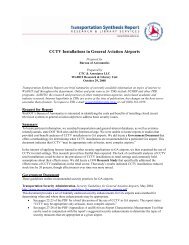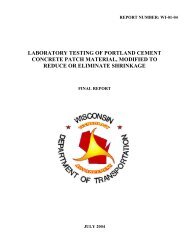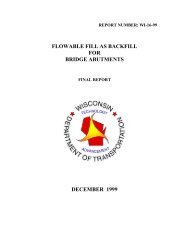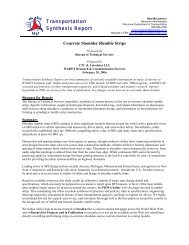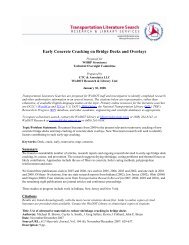Improved Life for Longitudinal Joints in Asphalt Pavement - WisDOT ...
Improved Life for Longitudinal Joints in Asphalt Pavement - WisDOT ...
Improved Life for Longitudinal Joints in Asphalt Pavement - WisDOT ...
Create successful ePaper yourself
Turn your PDF publications into a flip-book with our unique Google optimized e-Paper software.
<strong>WisDOT</strong> ApproachThe current <strong>WisDOT</strong> design of longitud<strong>in</strong>al jo<strong>in</strong>ts <strong>in</strong> asphalt pavement is a “Michigan jo<strong>in</strong>t” or “wedge jo<strong>in</strong>t”design. It features a ½-<strong>in</strong>ch notch at the top of the jo<strong>in</strong>t, a vertical drop perpendicular to the lane surface, and a 12:1tapered slope <strong>in</strong>to the space where the next lane will be laid. This jo<strong>in</strong>t is treated with a tack coat and the next layeris rolled over the jo<strong>in</strong>t slope. If the jo<strong>in</strong>t is cold, it is heated and tacked and the next lane is placed. See <strong>WisDOT</strong>Standard Specifications, Sections 450.3.2.5(6) and 450.3.2.8, athttp://roadwaystandards.dot.wi.gov/standards/stndspec/sect450.pdf (pages 5 to 6 of the PDF). For a draw<strong>in</strong>g, see the<strong>WisDOT</strong> Facilities Development Manual, Chapter 14, Procedure 14-10-5, Figure 5, athttp://roadwaystandards.dot.wi.gov/standards/fdm/14/FDM14.pdf (page 29 of the PDF).Jo<strong>in</strong>t DesignThe Michigan or tapered jo<strong>in</strong>t became the standard <strong>in</strong> the 1990s. A variety of publications have spun off NCATReport No. 97-4, published <strong>in</strong> 1997, which <strong>for</strong>mally established the effectiveness of the tapered or notched jo<strong>in</strong>t.National Center <strong>for</strong> <strong>Asphalt</strong> Technology. S<strong>in</strong>ce at least the late 1990s, the Michigan or tapered jo<strong>in</strong>t design hasbeen considered the best option <strong>for</strong> longitud<strong>in</strong>al jo<strong>in</strong>ts <strong>in</strong> asphalt pavements and asphalt overlays. An NCAT studycompared jo<strong>in</strong>ts <strong>in</strong> Michigan, Wiscons<strong>in</strong>, Colorado and Pennsylvania, and the results led to a number of later articlesand studies. These <strong>in</strong>clude:• <strong>Longitud<strong>in</strong>al</strong> Jo<strong>in</strong>t Construction Techniques <strong>for</strong> <strong>Asphalt</strong> <strong>Pavement</strong>s, Prithvi Kandhal and Rajib Mallick,NCAT Report No. 97-4, August 1997.http://ntl.bts.gov/lib/7000/7900/7944/rep97-4.pdfThis project studied 30 designs <strong>in</strong> four states. The best-per<strong>for</strong>m<strong>in</strong>g jo<strong>in</strong>t after four years was a Michiganjo<strong>in</strong>t that featured a 12.5-mm vertical offset and a 12:1 taper.• A 2007 NCAT PowerPo<strong>in</strong>t presentation <strong>in</strong>cludes material from the 1997 study (seehttp://www.ucs.iastate.edu/mnet/_repository/2007/asphalt/pdf/practices%20and%20specifications%20<strong>for</strong>%20longitud<strong>in</strong>al%20jo<strong>in</strong>ts%20-%20prowell.pdf). The presentation discusses measur<strong>in</strong>g per<strong>for</strong>mance at thetime of construction, describes German methods, and presents four states’ specifications. Best-per<strong>for</strong>m<strong>in</strong>gmethods <strong>for</strong> construction <strong>in</strong>clude:o Use of rubberized jo<strong>in</strong>t adhesiveo Notched-wedge design, with a 12:1 taper over 12 <strong>in</strong>ches, and a notch of 0.5 to 0.75 <strong>in</strong>cheso Use of cutt<strong>in</strong>g wheel and edge-restra<strong>in</strong><strong>in</strong>g deviceo Roll<strong>in</strong>g from hot side with 6-<strong>in</strong>ch overlap• A PowerPo<strong>in</strong>t presentation on the NCAT data confirms the Michigan jo<strong>in</strong>t’s effectiveness, and notesseveral factors <strong>in</strong> effective jo<strong>in</strong>t construction (seehttp://www.asphaltalliance.com/upload/<strong>Longitud<strong>in</strong>al</strong>%20<strong>Jo<strong>in</strong>ts</strong>%20-%20Ray%20Brown.pdf). Conclusions<strong>in</strong>clude:o Vertical offsets are essential.o Rubberized jo<strong>in</strong>t adhesive is effective.o Roll<strong>in</strong>g should be conducted as soon as possible.o The jo<strong>in</strong>t can be compacted to a density with<strong>in</strong> 2 percent of the mat density.• See also “Study of <strong>Longitud<strong>in</strong>al</strong>-Jo<strong>in</strong>t Construction Techniques <strong>in</strong> Hot-Mix <strong>Asphalt</strong> <strong>Pavement</strong>s,” PrithviKandhal and Rajib Mallick, Transportation Research Record No. 1543, 1996: 106-112. (See attached file.)• The “New Jersey” jo<strong>in</strong>t, one of the other designs tried and found less effective, is a 3:1 wedge without anotch at the unconf<strong>in</strong>ed edge of the first lane that is heated be<strong>for</strong>e the next lane is placed.• “<strong>Asphalt</strong> Answers,” Roads and Bridges Magaz<strong>in</strong>e, January 1998.http://www.roadsbridges.com/ASPHALT-ANSWERS-article973Kandhal writes that after five years, the Michigan jo<strong>in</strong>t rema<strong>in</strong>s the most promis<strong>in</strong>g design.TRB“Evaluation of Notched-Wedge <strong>Longitud<strong>in</strong>al</strong> Jo<strong>in</strong>t Construction,” M. Shane Buchanan, Transportation ResearchRecord No. 1712, 2000: 50-57. (See attached file.)This paper, from the 2000 TRB Annual Meet<strong>in</strong>g, follows up on notched-wedge jo<strong>in</strong>ts <strong>in</strong> Alabama, Colorado,Indiana, Maryland and Wiscons<strong>in</strong>, and f<strong>in</strong>ds from cores that they’ve been per<strong>for</strong>m<strong>in</strong>g well <strong>in</strong> terms of density at thelongitud<strong>in</strong>al jo<strong>in</strong>t.2
Compaction and DensityProper density and compaction at the longitud<strong>in</strong>al jo<strong>in</strong>t present difficulties to construction crews. For the first pavedlane, roller passes push material out, result<strong>in</strong>g <strong>in</strong> reduced density at the edge. In pav<strong>in</strong>g a second lane, with aconf<strong>in</strong>ed edge at the first, proper compaction at the jo<strong>in</strong>t can be hampered by cool<strong>in</strong>g of the HMA. Many of thereports below focus on the effectiveness of a density or permeability specification—<strong>in</strong> some cases with <strong>in</strong>centives ordis<strong>in</strong>centives to <strong>for</strong>ce contractor compliance. The follow<strong>in</strong>g research and documents focus on density andcompaction of longitud<strong>in</strong>al jo<strong>in</strong>ts <strong>in</strong> terms of construction, specifications, quality and per<strong>for</strong>mance.NCHRP. Project 9-15, “Quality Characteristics and Test Methods <strong>for</strong> Use <strong>in</strong> Per<strong>for</strong>mance-Related Specifications ofHot Mix <strong>Asphalt</strong> <strong>Pavement</strong>s,” completed June 2004.http://www.trb.org/trbnet/projectdisplay.asp?projectid=951Phase I identified construction-based per<strong>for</strong>mance characteristics of HMA pavements that warrant test<strong>in</strong>g <strong>for</strong> qualityassurance, and distilled these to five characteristics <strong>for</strong> test<strong>in</strong>g; longitud<strong>in</strong>al jo<strong>in</strong>t density was one of these. Phase IItested these qualities with available methods to determ<strong>in</strong>e best methods and quality standards.For a detailed summary of f<strong>in</strong>d<strong>in</strong>gs, see Research Results Digest 291, August 2004, athttp://onl<strong>in</strong>epubs.trb.org/onl<strong>in</strong>epubs/nchrp/nchrp_rrd_291.pdf. The digest addresses longitud<strong>in</strong>al jo<strong>in</strong>t density onpages 5-6. Research compared density read<strong>in</strong>gs from a pavement quality <strong>in</strong>dicator, a nuclear gauge, and frompavement cores, f<strong>in</strong>d<strong>in</strong>g PQI results the most accurate. Based on PQI read<strong>in</strong>gs, <strong>in</strong>vestigators categorized jo<strong>in</strong>tdensity relative to lane or mat density <strong>in</strong> three classifications as a guidel<strong>in</strong>e <strong>for</strong> specifications:• Good density at the jo<strong>in</strong>t measures greater than 97 percent of mat density.• Fair density at the jo<strong>in</strong>t measures 93 to 97 percent.• Poor density at the jo<strong>in</strong>t measures less than 93 percent.KentuckyCompaction at the <strong>Longitud<strong>in</strong>al</strong> Construction Jo<strong>in</strong>t <strong>in</strong> <strong>Asphalt</strong> <strong>Pavement</strong>s, L. John Fleckenste<strong>in</strong>, David Allen andDavid Schultz Jr., March 2002.http://www.ktc.uky.edu/Reports/KTC_02_10_SPR200_00_1F.pdfInvestigators tracked jo<strong>in</strong>t construction at 12 pavement sites dur<strong>in</strong>g construction, evaluat<strong>in</strong>g the density achieved onthe longitud<strong>in</strong>al jo<strong>in</strong>ts. Four construction approaches were used, <strong>in</strong>clud<strong>in</strong>g build<strong>in</strong>g notched-wedge (12:1) jo<strong>in</strong>ts aswell as us<strong>in</strong>g a restra<strong>in</strong>ed edge, a jo<strong>in</strong>t re-heater and a Jo<strong>in</strong>t Maker. All jo<strong>in</strong>ts were per<strong>for</strong>m<strong>in</strong>g well afterconstruction. Those that employed jo<strong>in</strong>t adhesives were per<strong>for</strong>m<strong>in</strong>g as well as or better than those that did not,lead<strong>in</strong>g <strong>in</strong>vestigators to recommend the use of jo<strong>in</strong>t adhesives.TRBFactors Affect<strong>in</strong>g Compaction of <strong>Asphalt</strong> <strong>Pavement</strong>s, Transportation Research Circular E-C105, September 2006.http://onl<strong>in</strong>epubs.trb.org/onl<strong>in</strong>epubs/circulars/ec105.pdfThis e-circular <strong>in</strong>cludes four articles on longitud<strong>in</strong>al jo<strong>in</strong>t construction, beg<strong>in</strong>n<strong>in</strong>g on page 85 of the PDF. Topics<strong>in</strong>clude compaction, voids, measur<strong>in</strong>g density at jo<strong>in</strong>ts, and durable jo<strong>in</strong>t construction. Important factors <strong>in</strong> build<strong>in</strong>gdurable jo<strong>in</strong>ts <strong>in</strong>clude:• Proper compaction of the unsupported edge of the first lane placed.• Ensur<strong>in</strong>g that overlap of asphalt from the second lane placed is about 1 to 1.5 <strong>in</strong>ches to ensure enoughmixture <strong>in</strong> the new lane <strong>for</strong> a properly compacted lift and to prevent a depression between lanes. Overlapon the first lane must be shoveled off the pavement, not raked <strong>in</strong>to the new lane.• Plac<strong>in</strong>g the mixture precisely enough to avoid rak<strong>in</strong>g at the jo<strong>in</strong>t.• Compact<strong>in</strong>g the jo<strong>in</strong>t from the warm pavement lane, not the cold, and allow<strong>in</strong>g the roller to extend no morethan 6 <strong>in</strong>ches over the cold lane.Construction and SpecificationsThe follow<strong>in</strong>g activities focus on construction techniques and activities, as well as on the development andeffectiveness of a density specification <strong>for</strong> longitud<strong>in</strong>al jo<strong>in</strong>ts.Kansas<strong>Longitud<strong>in</strong>al</strong> Jo<strong>in</strong>t Construction <strong>for</strong> Hot Mix <strong>Asphalt</strong> <strong>Pavement</strong>s, M.V. Akp<strong>in</strong>ar and M. Hossa<strong>in</strong>, March 2004.http://www.ksdot.org/idmws/DocContent.dll?Library=PublicDocs^dt00mx38&ID=003686991&Page=1This literature search explores density problems at the longitud<strong>in</strong>al jo<strong>in</strong>t, <strong>in</strong>clud<strong>in</strong>g construction techniques andspecifications from various studies.3
Ma<strong>in</strong>e“<strong>Longitud<strong>in</strong>al</strong> Jo<strong>in</strong>t Study,” Federal Experimental Report 96-2, September 2001.http://ma<strong>in</strong>egov-images.<strong>in</strong><strong>for</strong>me.org/mdot/transportation-research/pdf/report9602f.pdfThis five-year study of longitud<strong>in</strong>al jo<strong>in</strong>ts constructed <strong>in</strong> 1996 evaluated various methods of longitud<strong>in</strong>al jo<strong>in</strong>tconstruction dur<strong>in</strong>g roll<strong>in</strong>g of HMA pavement. Jo<strong>in</strong>t-mak<strong>in</strong>g equipment, roll<strong>in</strong>g patterns, edge trimm<strong>in</strong>g and othertechniques were evaluated <strong>in</strong> various comb<strong>in</strong>ations. The best per<strong>for</strong>mance was <strong>in</strong> the section <strong>in</strong> which roll<strong>in</strong>g wasconducted from the cold mat with a 6-<strong>in</strong>ch overlap <strong>in</strong>to the hot mat; this method is the reverse of the recommendedmethod by NCAT and other studies.New Hampshire“Field Trial of Infrared Jo<strong>in</strong>t Heater to Improve <strong>Longitud<strong>in</strong>al</strong> Jo<strong>in</strong>t Per<strong>for</strong>mance <strong>in</strong> New Hampshire,” Jo Sias Daniel,University of New Hampshire, and William Real, NHDOT; Transportation Research Record No. 1946, 2006: 157-162. (See attached file.)This field study evaluated the use of <strong>in</strong>frared jo<strong>in</strong>t heaters to improve longitud<strong>in</strong>al jo<strong>in</strong>t per<strong>for</strong>mance. The heateressentially affects only the top layer of the full-depth asphalt structure, suggest<strong>in</strong>g potential <strong>for</strong> us<strong>in</strong>g this methodwith overlays.Ontario“<strong>Longitud<strong>in</strong>al</strong> Jo<strong>in</strong>t Compaction: Improv<strong>in</strong>g Paved Lanes,” Road Talk, Vol. 10 (2), May 2004.http://www.mto.gov.on.ca/english/transtek/roadtalk/rt10-2/<strong>in</strong>dex.html#jo<strong>in</strong>tThe Ontario M<strong>in</strong>istry of Transportation evaluated the use of <strong>in</strong>centives and test<strong>in</strong>g of density at jo<strong>in</strong>ts to ensure thatjo<strong>in</strong>ts were constructed as specified. Investigators evaluated the long-term per<strong>for</strong>mance of four trial sections paved<strong>in</strong> 1997 <strong>in</strong> which compaction was tested at the longitud<strong>in</strong>al jo<strong>in</strong>ts to ensure contractor compliance, not a requirementat the time. Trials <strong>in</strong>cluded both standard and unconventional methods and equipment. Highlights <strong>in</strong>clude:• Four methods were evaluated, <strong>in</strong>clud<strong>in</strong>g standard pav<strong>in</strong>g and compaction, use of a jo<strong>in</strong>t heater, use of ajo<strong>in</strong>t-build<strong>in</strong>g system with a compactor and kicker-plates as well as an electronic monitor<strong>in</strong>g device, anduse of both a heater and the jo<strong>in</strong>t<strong>in</strong>g and monitor<strong>in</strong>g system.• No method proved superior to the others, but all achieved compaction rates of 95 percent or greater.• After four years and after six years, jo<strong>in</strong>ts were <strong>in</strong> excellent condition.• Contractor per<strong>for</strong>mance has been encouraged through bonuses <strong>for</strong> meet<strong>in</strong>g standards on 95 percent or moreof exam<strong>in</strong>ed edges, and penalties <strong>for</strong> meet<strong>in</strong>g standards at 90 percent or less of exam<strong>in</strong>ed edge po<strong>in</strong>ts.PennsylvaniaEvaluation of Eight <strong>Longitud<strong>in</strong>al</strong> Jo<strong>in</strong>t Construction Techniques <strong>for</strong> <strong>Asphalt</strong> <strong>Pavement</strong>s <strong>in</strong> Pennsylvania, PrithviKandhal, Timothy Ramirez and Paul Ingram, NCAT Report No. 2002-03, February 2002.http://www.eng.auburn.edu/center/ncat/reports/rep02-03.pdfFollow<strong>in</strong>g up on some of the sites <strong>in</strong>cluded <strong>in</strong> the 1997 NCAT study, researchers evaluated the six-year per<strong>for</strong>manceof the eight techniques used <strong>in</strong> Pennsylvania <strong>in</strong> 1995. F<strong>in</strong>d<strong>in</strong>gs <strong>in</strong>cluded:• <strong>Jo<strong>in</strong>ts</strong> us<strong>in</strong>g rubberized jo<strong>in</strong>t material had per<strong>for</strong>med best.• The jo<strong>in</strong>t constructed us<strong>in</strong>g a cutt<strong>in</strong>g wheel was a close second.• Sections on which roll<strong>in</strong>g from the hot side away from the jo<strong>in</strong>t was used per<strong>for</strong>med reasonably well.• The New Jersey wedge jo<strong>in</strong>t per<strong>for</strong>med reasonably well.TexasDensity Evaluation of the <strong>Longitud<strong>in</strong>al</strong> Construction Jo<strong>in</strong>t of Hot-Mix <strong>Asphalt</strong> <strong>Pavement</strong>s, C<strong>in</strong>dy Estakhri, ThomasFreeman and Clif<strong>for</strong>d Spiegelman, Texas Transportation Institute: April 2001.http://tti.tamu.edu/documents/1757-1.pdfThis Texas study of density <strong>in</strong> longitud<strong>in</strong>al jo<strong>in</strong>ts <strong>in</strong> HMA evaluated jo<strong>in</strong>ts at 35 sites, considered airfield andpavement regulations, and conducted laboratory tests. One of the study’s goals was to identify the viability of adensity specification <strong>for</strong> longitud<strong>in</strong>al jo<strong>in</strong>ts <strong>in</strong> asphalt pavement, and <strong>in</strong>vestigators developed and proposed aspecification. F<strong>in</strong>d<strong>in</strong>gs <strong>in</strong>clude:• Some states and the Federal Aviation Adm<strong>in</strong>istration ma<strong>in</strong>ta<strong>in</strong> a density specification <strong>for</strong> longitud<strong>in</strong>al jo<strong>in</strong>ts<strong>in</strong> asphalt, and contractors have little trouble meet<strong>in</strong>g the requirement.• Density was always lower at the unconf<strong>in</strong>ed edge of the pavement than at the middle of the lane. Thedifference averaged about 4 to 5 percent, about 6 to 7 pounds per cubic foot.• The proposed specification would require the difference to be kept to 5 pounds per cubic foot.4
Wash<strong>in</strong>gton State“<strong>Longitud<strong>in</strong>al</strong> Jo<strong>in</strong>t Construction Techniques,” Wash<strong>in</strong>gton State DOT Tech Notes, February 2003.http://www.wsdot.wa.gov/biz/mats/<strong>Pavement</strong>/TechNotes/<strong>Longitud<strong>in</strong>al</strong>Jo<strong>in</strong>tConstruction.PDFThis construction primer draws heavily on the Pennsylvania study, NCAT Report No. 2002-03 above.Recommendations and observations <strong>in</strong>clude:• Notched-wedge jo<strong>in</strong>ts outper<strong>for</strong>m jo<strong>in</strong>ts with no notch, <strong>in</strong>clud<strong>in</strong>g the New Jersey jo<strong>in</strong>t.• Whatever jo<strong>in</strong>t design is used, roll from the hot mat side.• Rubberized sealants per<strong>for</strong>m well.• Specify density with<strong>in</strong> 2 percent of the mat density.• Follow the NCAT recommendation that there be no more than 10 percent air voids.Contact: Jeff Uhlmeyer, (360) 709-5485, uhlmeyj@wsdot.wa.gov.SealantsThe follow<strong>in</strong>g documents perta<strong>in</strong> to the per<strong>for</strong>mance of jo<strong>in</strong>t sealants <strong>in</strong> mitigat<strong>in</strong>g or prevent<strong>in</strong>g longitud<strong>in</strong>al jo<strong>in</strong>tfailures.Ill<strong>in</strong>oisInterim Report: Experimental Jo<strong>in</strong>t Sealants <strong>for</strong> Hot Mix <strong>Asphalt</strong> <strong>Pavement</strong>s and Overlays, In-House Report No.I2004-07, October 2004.http://www.dot.state.il.us/materials/research/i2004-07.pdfThis research focused on construction and test<strong>in</strong>g of sealants <strong>for</strong> longitud<strong>in</strong>al jo<strong>in</strong>ts at two Interstate sites and twostate highway sites <strong>in</strong> 2003. At two of the four project sites, sealants were <strong>in</strong>effective at reduc<strong>in</strong>g permeability; at theother two, the sealants had some impact but were still sticky enough to adhere to the tires of pass<strong>in</strong>g vehicles. J-Band was easy to place, while QuickSeam was difficult.The study is expected to conclude <strong>in</strong> 2009; see the TRB Research <strong>in</strong> Progress entry athttp://rip.trb.org/browse/dproject.asp?n=13344.Contacts: Aaron Toliver, Pr<strong>in</strong>cipal Investigator, (217) 782-0564, aaron.t.toliver@ill<strong>in</strong>ois.gov. LaDonna Rowden,Bureau of Materials and Physical Research, (217) 782-8582, LaDonna.Rowden@ill<strong>in</strong>ois.gov.Video: Evaluation of <strong>Longitud<strong>in</strong>al</strong> Jo<strong>in</strong>t Sealant, Ill<strong>in</strong>ois Department of Transportation, 2003.http://www.state.il.us/video/stream<strong>in</strong>g/idot/V181.asxThis video demonstrates research and use of two sealants designed to reduce longitud<strong>in</strong>al jo<strong>in</strong>t damage.Ma<strong>in</strong>e<strong>Longitud<strong>in</strong>al</strong> Jo<strong>in</strong>t Treatment, F<strong>in</strong>al Report, Technical Report 00-18, March 2006.http://ma<strong>in</strong>egov-images.<strong>in</strong><strong>for</strong>me.org/mdot/transportation-research/pdf/report0018f<strong>in</strong>al.pdfThis study evaluated three jo<strong>in</strong>t sealants over a six-year period to test their per<strong>for</strong>mance <strong>in</strong> prevent<strong>in</strong>g jo<strong>in</strong>tseparation. All jo<strong>in</strong>ts per<strong>for</strong>med well, and <strong>in</strong>spection did not f<strong>in</strong>d any significant difference <strong>in</strong> per<strong>for</strong>mance betweenthe three sealants.New York“Constructability of <strong>Longitud<strong>in</strong>al</strong> Construction <strong>Jo<strong>in</strong>ts</strong> <strong>in</strong> Hot-Mix <strong>Asphalt</strong> <strong>Pavement</strong>s with Sealers to Retard FutureDeterioration,” Edward Denehy, Transportation Research Circular E-C078: Roadway <strong>Pavement</strong> Preservation,2005, October 2005.http://www.trb.org/publications/circulars/ec078.pdf (pages 16 to 23 of the PDF)Sealants were used <strong>in</strong> longitud<strong>in</strong>al jo<strong>in</strong>t construction of notched-wedge jo<strong>in</strong>ts <strong>in</strong> Pennsylvania, and NYSDOT<strong>in</strong>vestigated the constructability of us<strong>in</strong>g adhesives dur<strong>in</strong>g pav<strong>in</strong>g <strong>in</strong> the summer of 2004 by hav<strong>in</strong>g three contractorsconstruct HMA pilot projects, each with a different sealant. Sealant use had no negative effect on pav<strong>in</strong>g activitiesor compaction.5
Quality ControlThe follow<strong>in</strong>g research focuses on the use of field permeameters <strong>for</strong> quality-control monitor<strong>in</strong>g of longitud<strong>in</strong>aljo<strong>in</strong>ts.New England Transportation ConsortiumProject 03-5, Evaluation of a Field Permeameter as a <strong>Longitud<strong>in</strong>al</strong> Jo<strong>in</strong>t Quality Indicator, Jo Sias Daniel, RajibMallick and Walaa Mogawer, University of New Hampshire, April 2007.http://www.netc.umassd.edu/netc03_5_f<strong>in</strong>al_report.pdfThis study sought to evaluate the use of field permeameters <strong>for</strong> evaluat<strong>in</strong>g the quality of constructed longitud<strong>in</strong>aljo<strong>in</strong>ts. Various construction methods were used, <strong>in</strong>clud<strong>in</strong>g the use of <strong>in</strong>frared heaters and jo<strong>in</strong>t sealants. Based ondensity, air void content and strength from cores, conclusions <strong>in</strong>cluded:• Permeameter use is promis<strong>in</strong>g but requires ref<strong>in</strong>ement to reduce variability.• Jo<strong>in</strong>t sealants and jo<strong>in</strong>t heaters improve short-term jo<strong>in</strong>t per<strong>for</strong>mance.See also “Development and Evaluation of a Field Permeameter as a <strong>Longitud<strong>in</strong>al</strong> Jo<strong>in</strong>t Quality Indicator,” R.B.Mallick and J. Daniel, International Journal of <strong>Pavement</strong> Eng<strong>in</strong>eer<strong>in</strong>g, Vol. 7 (1), March 2006: 11-21. View theabstract at http://www.<strong>in</strong><strong>for</strong>maworld.com/smpp/content~content=a741577671~db=all~order=page.Research <strong>in</strong> ProgressFive ongo<strong>in</strong>g projects perta<strong>in</strong> to longitud<strong>in</strong>al jo<strong>in</strong>t characteristics and construction.Arkansas“HMA <strong>Longitud<strong>in</strong>al</strong> Jo<strong>in</strong>t Evaluation and Construction,” expected completion date June 2009.http://rip.trb.org/browse/dproject.asp?n=13587Arkansas is evaluat<strong>in</strong>g the use of a density specification <strong>for</strong> quality control.Contacts: Mark Greenwood, Project Manager, (501) 569-2552, mark.greenwood@arkansashighways.com. StacyWilliams, Pr<strong>in</strong>cipal Investigator, (479) 575-2220, sgwill@engr.uark.edu.Colorado“Evaluation of <strong>Longitud<strong>in</strong>al</strong> Jo<strong>in</strong>t Density,” expected completion date December 2010.http://rip.trb.org/browse/dproject.asp?n=9807Investigators are compar<strong>in</strong>g the longitud<strong>in</strong>al jo<strong>in</strong>t density of seven asphalt pavement projects constructed <strong>in</strong> 2004under a density specification to seven projects constructed <strong>in</strong> 2000 without such a specification.Contacts: Roberto de Dios, Project Manager, (303) 757-9975, roberto.dedios@dot.state.co.us. David Weld,Pr<strong>in</strong>cipal Investigator, (425) 284-3820, david@<strong>in</strong>rix.com.Ill<strong>in</strong>ois“Experimental Feature: Evaluat<strong>in</strong>g <strong>Longitud<strong>in</strong>al</strong> Jo<strong>in</strong>t Compaction Techniques,” no expected completion date given.http://rip.trb.org/browse/dproject.asp?n=5482This project is evaluat<strong>in</strong>g longitud<strong>in</strong>al jo<strong>in</strong>t construction techniques, specifications and elim<strong>in</strong>ation of pneumaticrollers.Contact: Tessa Volle, Pr<strong>in</strong>cipal Investigator, (217) 782-3547, volleth@nt.dot.state.il.us.Oklahoma“<strong>Longitud<strong>in</strong>al</strong> Jo<strong>in</strong>t Density and Permeability <strong>in</strong> <strong>Asphalt</strong> Concrete,” expected completion date 2008.http://rip.trb.org/browse/dproject.asp?n=12547Oklahoma does not have a density specification; this study will use field and laboratory methods to develop a testmethod and a specification <strong>for</strong> ensur<strong>in</strong>g optimal density and permeability of longitud<strong>in</strong>al jo<strong>in</strong>ts. Also see the FFY07Problem Statement at http://www.okladot.state.ok.us/hqdiv/p-r-div/spr-statements/pdfs/statements.pdf (page 5 of thePDF).Contact: Stephen Cross, Pr<strong>in</strong>cipal Investigator, (785) 864-4290, sac@kuhub.ccukans.edu.6
Tennessee“Evaluation of <strong>Longitud<strong>in</strong>al</strong> <strong>Jo<strong>in</strong>ts</strong> of HMA <strong>Pavement</strong>s <strong>in</strong> Tennessee,” expected completion date July 2008.http://rip.trb.org/browse/dproject.asp?n=15419Tennessee <strong>in</strong>vestigators believe longitud<strong>in</strong>al jo<strong>in</strong>t failures may be related to compaction difficulties due totemperature differences between lanes, and the <strong>in</strong>effectiveness of adhesives under such conditions.7



